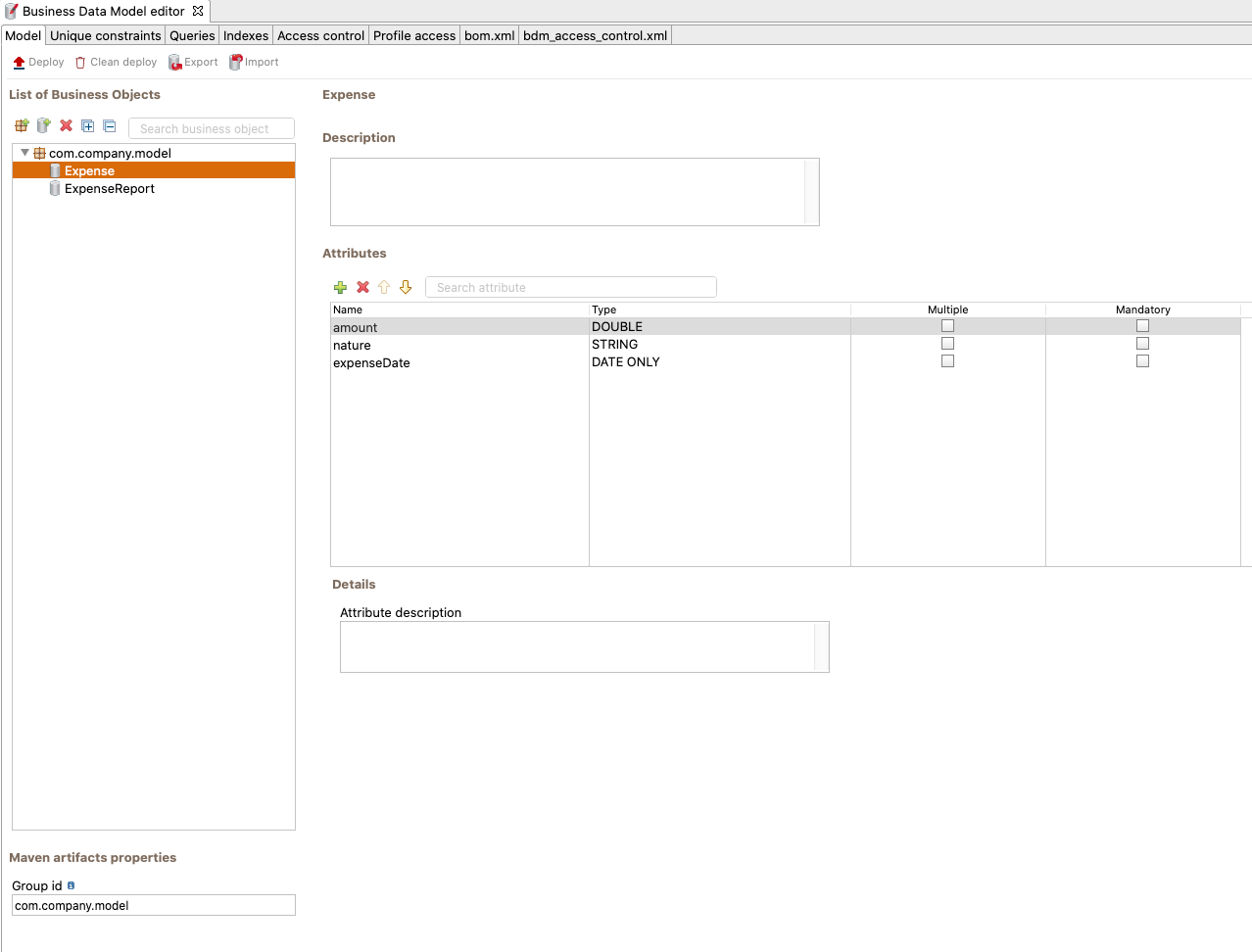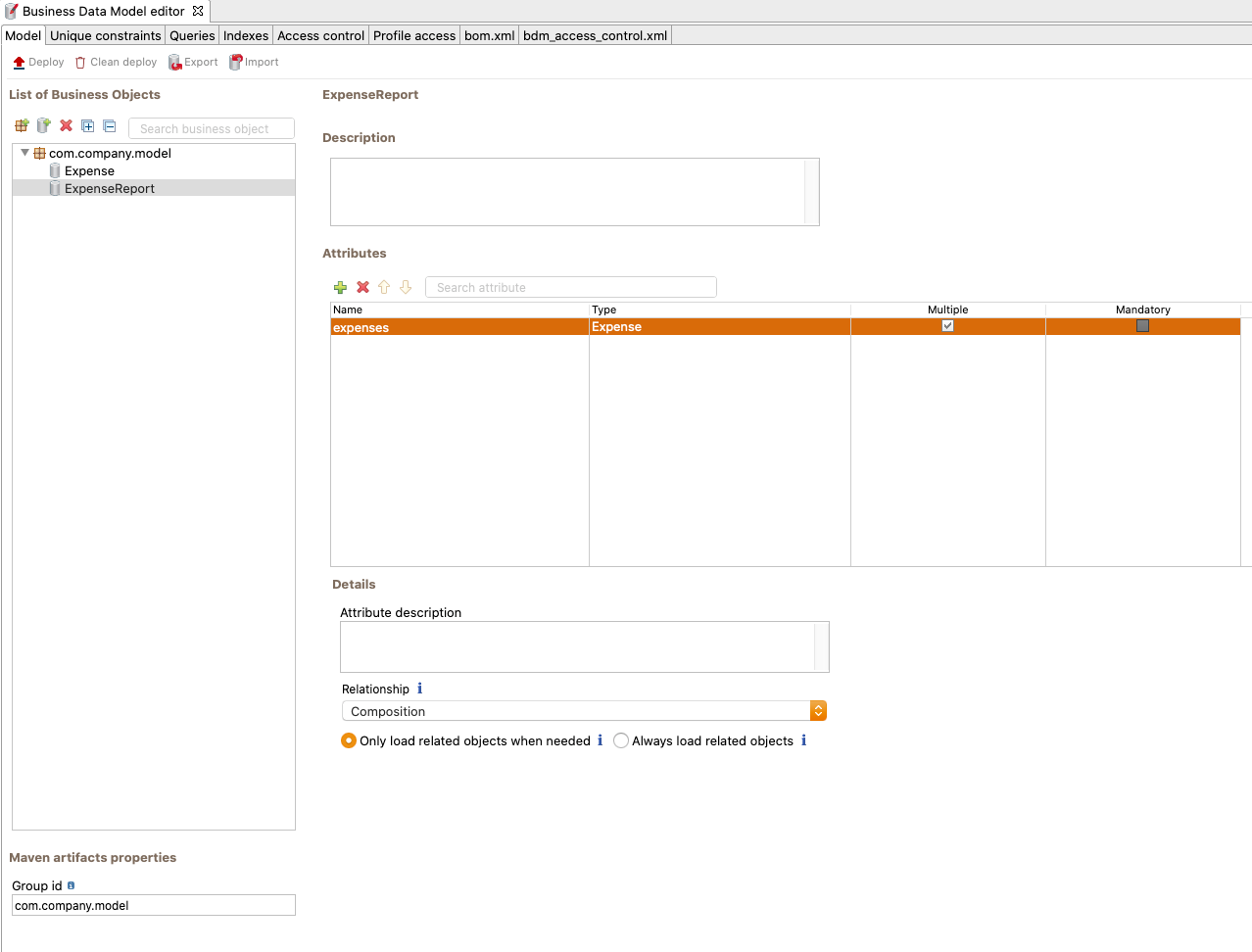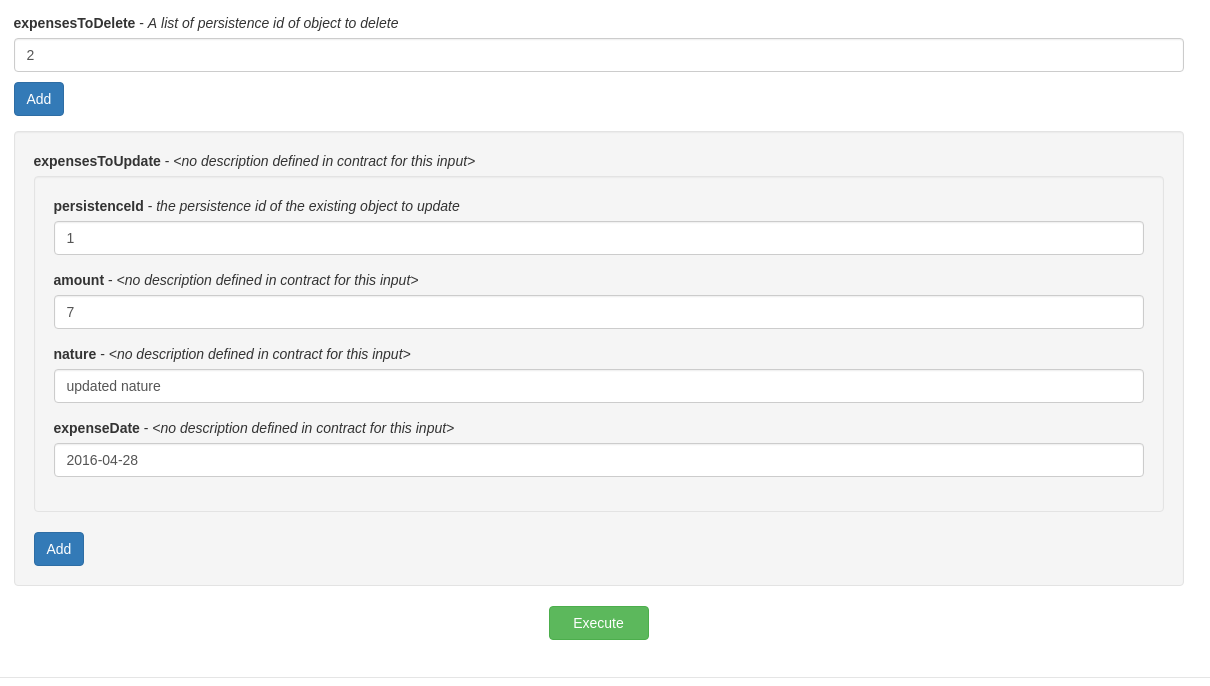How to manage multiple references in Business Objects
Tutorial for managing multiple references in the BDM Business Objects.
Introduction
This tutorial explains how to create, update or delete a multiple reference in a Business Object. The tutorial can be used with Bonita Community edition, and uses features that are available in all editions. The example uses an expense report as business object.
Design a task contract and associated operations to update a business object with a multiple reference.
Create the business object model
Create an Expense business object like below.

Then create ExpenseReport business object referencing multiple expenses by composition.

Design the expense report process
-
Create a new process
-
Add a new report business variable of type ExpenseReport initialized with following groovy script
def aDummyExpense = expenseDAO.newInstance();
aDummyExpense.amount = 5
aDummyExpense.nature = "A dummy expense"
aDummyExpense.expenseDate = new Date()
def anotherDummyExpense = expenseDAO.newInstance();
anotherDummyExpense.amount = 55
anotherDummyExpense.nature = "A another dummy expense"
anotherDummyExpense.expenseDate = new Date()
def report = expenseReportDAO.newInstance()
report.expenses << aDummyExpense
report.expenses << anotherDummyExpense
return report-
Rename Step1 to Update expense report
Design the task contract to update expenses
-
Select the Update expense report task
-
Go to Execution > Contract property tab
-
Create a contract like below

newExpenses input is used to gather a list of new expenses to add to the report expensesToDelete input is used to gather a list of Expense id to delete expensesToUpdate input is used to gather a list of existing expenses to update in the report
In the contract we use TEXT input type for persistenceId instead of numeric type to support the whole java.lang.Long range. JSON number type range does not extend to java.lang.Long.MAX_VALUE. A conversion to long will be applied in scripts.
Add operations to update the business data
-
Go to Execution > Operations property tab
-
Add an operation
-
Use the report business variable as left operand.
-
Change the operator and select Use a java method, choose the setExpenses method.
-
In the right operand use the following script to add new expenses in the report:
def result = []
result.addAll(report.getExpenses())
newExpenses.each{
def exp = expenseDAO.newInstance()
exp.amount = it.amount
exp.nature = it.nature
exp.expenseDate = it.expenseDate
result << exp
}
return result-
Add another operation
-
Use the report business variable as left operand.
-
Change the operator and select Use a java method, choose the setExpenses method.
-
In the right operand use the following script to delete expenses from the report:
def result = []
result.addAll(report.getExpenses())
result.removeAll(result.findAll{expensesToDelete.contains(it.persistenceId.toString())})
return result-
Add another operation
-
Use the report business variable as left operand.
-
Change the operator and select Use a java method, choose the setExpenses method.
-
In the right operand use the following script to update expenses existing in the report:
import com.company.model.Expense;
def updatedExpenses = []
updatedExpenses.addAll(report.getExpenses())
expensesToUpdate.each{ exp ->
def Expense expenseToUpdate = updatedExpenses.find{
it.persistenceId == exp.persistenceId.toLong()
}
if(expenseToUpdate){
expenseToUpdate.amount = exp.amount
expenseToUpdate.expenseDate = exp.expenseDate
expenseToUpdate.nature = exp.nature
}else{
throw new Exception("Expense with id $exp.persistenceId does not exists.")
}
}
return updatedExpensesRun the process
You may now run the process and validate the expected behavior using autogenerated forms.
-
Click on Run
-
Start the process instance form the autogenerated form
-
In a web browser, you can check the content of your report calling the following Rest API: http://localhost:8080/bonita/API/bdm/businessData/com.company.model.ExpenseReport/1/expenses
It should display this result according to the initialization of the report business variable.
[
{
"persistenceId":1,
"persistenceId_string":"1",
"persistenceVersion":0,
"persistenceVersion_string":"0",
"amount":5.0,
"amount_string":"5.0",
"nature":"A dummy expense",
"expenseDate":1461748727495
},
{
"persistenceId":2,
"persistenceId_string":"2",
"persistenceVersion":0,
"persistenceVersion_string":"0",
"amount":55.0,
"amount_string":"55.0",
"nature":"A another dummy expense",
"expenseDate":1461748727495
}
]-
Perform the Update expense report task like below


-
In a web browser, check the content of your report calling the following Rest API: http://localhost:8080/bonita/API/bdm/businessData/com.company.model.ExpenseReport/1/expenses
It should display the following result:
[
{
"persistenceId":1,
"persistenceId_string":"1",
"persistenceVersion":1,
"persistenceVersion_string":"1",
"amount":7.0,
"amount_string":"7.0",
"nature":"updated nature",
"expenseDate":1461801600000
},
{
"persistenceId":3,
"persistenceId_string":"3",
"persistenceVersion":0,
"persistenceVersion_string":"0",
"amount":10.0,"amount_string":"10.0",
"nature":"new expense",
"expenseDate":1462406400000
}
]To conclude, when modifying a collection of Business objects in a script you must return new java.util.List instances and not the list returned by an accessor (eg: report.getExpenses()) as it will return an Hibernate specific implementation not compliant with our business objects. Do not forget to use the persistence id (or another unique attribute of the object) in the contract if you need to access existing object (update or delete usecases).